20 Most Popular Foods You Have To Eat In Iran
Iran has a rich culinary tradition with a wide variety of delicious dishes. Here are 15 popular foods you must try when visiting Iran:
1.Kebab
Iran is famous for its succulent and flavorful kebabs, particularly koobideh (ground meat kebabs) and jujeh (chicken kebabs). They are typically served with saffron-infused rice.
Chelow Kebab: This is a classic Iranian dish featuring grilled kebabs served with saffron rice and a side of butter and sumac.
Kebab, also spelled as kabob, is a popular and diverse category of grilled or skewered dishes that is enjoyed in many Middle Eastern, South Asian, and Mediterranean cuisines. In Iran, kebabs are an integral part of the culinary tradition and come in various styles and flavors. Here’s more information about kebabs in Iran:
Kebab Varieties: Iran offers a wide range of kebab varieties, with each region having its unique styles and ingredients. Some of the most popular Iranian kebabs include:
Koobideh Kebab: This is one of the most well-known Iranian kebabs. It’s made from ground meat, often a combination of beef and lamb, mixed with grated onions and spices. The meat is pressed onto skewers and grilled, resulting in flavorful and juicy kebabs.
Jujeh Kebab: Jujeh means chicken in Farsi. These kebabs are made from marinated pieces of chicken, often with saffron and lemon juice. They are skewered and grilled to perfection.
Barg Kebab: Barg means “filet” in Farsi. These kebabs are typically made with thinly sliced cuts of marinated meat, usually beef or lamb fillet. They are tender, succulent, and have a distinct flavor.
Chelow Kebab: This is a classic Iranian dish consisting of a serving of kebabs (usually koobideh or jujeh) along with a plate of saffron-infused rice, often served with grilled tomatoes and a pat of butter.
Marinades and Spices: Kebabs in Iran are often marinated with a blend of spices, herbs, and sometimes yogurt or lemon juice. Common spices used include saffron, sumac, turmeric, cumin, and ground black pepper. The marinades can vary from region to region.
Grilling Methods: Kebabs are traditionally cooked on open flame grills, allowing the meat to absorb the smoky flavors from the coals or wood. This grilling method imparts a unique, charred taste to the kebabs.
Accompaniments: Iranian kebabs are typically served with various accompaniments such as grilled tomatoes, roasted peppers, fresh herbs like mint and basil, and flatbreads like lavash or taftoon. You may also find sides like yogurt, saffron-infused rice, and sumac for added flavor.
Serving Styles: Kebabs can be served on a skewer or off the skewer, arranged on a platter or served with rice or flatbreads. The presentation can vary depending on the restaurant and the specific kebab style.
Iranian kebabs are not only known for their delicious flavors but also for the social aspect of sharing a meal. It’s common for friends and family to gather at kebab restaurants, making it a cherished part of Iranian culture and cuisine. Whether you’re trying koobideh, jujeh, or another variety, Iranian kebabs are a must-try when visiting the country.
Chelow Kebab is one of the most iconic and beloved dishes in Iranian cuisine. It’s a classic combination of grilled kebabs served with saffron-infused rice, often accompanied by a side of grilled tomatoes and a pat of butter. Here are more details about Chelow Kebab:
1. Rice (Chelow): The “Chelow” in Chelow Kebab refers to the steamed and fragrant Persian rice, which is a staple in Iranian meals. Saffron is a key ingredient in Iranian cuisine, and it’s used to give the rice a beautiful golden color and a subtly floral flavor. The rice is often parboiled, then steamed to perfection, resulting in fluffy, separated grains.
2. Kebabs: Chelow Kebab can feature various types of kebabs, but the two most common choices are:
Koobideh Kebab: Ground meat kebabs made from a mixture of finely ground lamb or beef (or a combination of both), grated onions, and a blend of spices. The mixture is then shaped around flat skewers and grilled, creating juicy and flavorful kebabs.
Jujeh Kebab: These are chicken kebabs, typically made from marinated chicken pieces, often with saffron, lemon juice, and various spices. The chicken is threaded onto skewers and grilled until tender and delicious.
3. Toppings and Sides: Chelow Kebab is often served with several accompaniments and toppings, which can include:
Grilled tomatoes and peppers: These add a smoky and slightly sweet flavor to complement the kebabs and rice.
Sumac: A tangy and slightly sour spice that is sometimes sprinkled over the rice or kebabs.
Butter: A small pat of butter is often placed on top of the rice, which melts and adds richness to the dish.
4. Variations: There are regional variations of Chelow Kebab in Iran, with different regions putting their unique spin on the dish. For example, in the city of Isfahan, you might find a version called “Beryani” which includes additional spices and flavors. In Tehran, you might encounter “Jujeh Chelow” which is essentially chicken Chelow Kebab with saffron rice.
5. Social and Cultural Significance: Chelow Kebab is not just about the food; it’s also a social and cultural experience in Iran. It’s a meal that is often shared with family and friends, and it’s a popular choice for gatherings, celebrations, and special occasions. The act of grilling kebabs over an open flame and sharing a meal together is a cherished part of Iranian culture.
Chelow Kebab is a must-try when visiting Iran, as it encapsulates the essence of Iranian cuisine, blending flavors of saffron, succulent grilled meat, and fragrant rice. It’s a dish that highlights the rich culinary traditions and warm hospitality of the country.
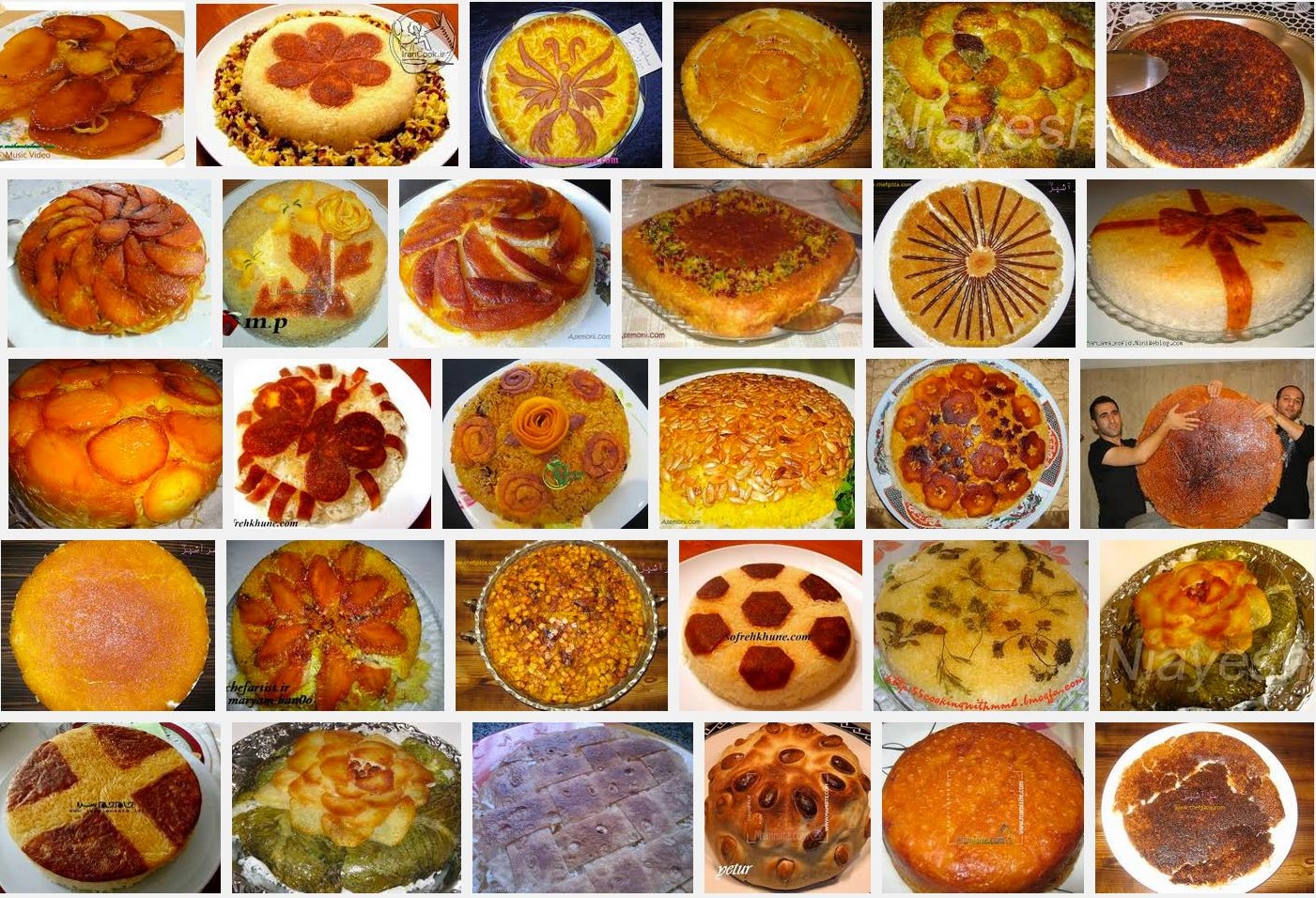
2.Tahdig
A crispy layer of rice formed at the bottom of the pot. It’s a favorite among Iranians and often flavored with saffron or yogurt.
Tahdig is a beloved and iconic Persian dish that’s often considered the “crown jewel” of Persian cuisine. It’s a crispy, golden crust of rice that forms at the bottom of the rice pot (or tahdig pot) during the cooking process. The word “Tahdig” itself means “bottom of the pot” in Persian. Here’s more information about this delightful Persian delicacy:
1. Ingredients: Tahdig is typically made from the same ingredients as the rice it accompanies. Basmati or long-grain rice is commonly used in Persian cuisine. Saffron is frequently used to infuse the rice with a beautiful golden hue and a subtle floral aroma. Other ingredients can include oil or butter, yogurt, or sometimes even thinly sliced potatoes.
2. Preparation: To make Tahdig, rice is washed and soaked, then parboiled in salted water until it’s partially cooked. The partially cooked rice is then drained. At this stage, various ingredients can be added for flavor and to help form the crust. Saffron-infused water, yogurt, or thinly sliced potatoes are common additions.
3. Layering: The partially cooked rice is layered in the pot. The layering process usually consists of alternating layers of rice and any additional ingredients used to form the crust. Saffron water, yogurt, or potato slices are often used for their flavor and texture.
4. Crisping Process: The pot is then placed on low heat and covered with a clean kitchen towel or a few layers of paper towels to prevent steam from escaping. The lid is then placed on top of the towel. The rice is cooked on low heat for an extended period of time, allowing the crust to form at the bottom of the pot. This slow cooking process results in a crispy, golden Tahdig.
5. Serving: Once the rice is fully cooked and the crust has formed, the pot is inverted onto a serving platter, revealing the golden Tahdig on top. The crunchy crust is then broken into pieces and served as a delicacy alongside the main rice dish, which is often a saffron-infused white rice or a flavored rice pilaf.
6. Variations: There are various ways to prepare Tahdig, and the choice of ingredients for the crust can vary. While saffron and yogurt are common, some people use thinly sliced potatoes, lavash bread, or even thinly sliced bread to create different textures and flavors.
Tahdig is not only a flavorful and texturally delightful element of Persian meals, but it’s also a source of pride and a symbol of hospitality in Iranian culture. It’s customary for the person who makes the best Tahdig to be considered an excellent cook. When enjoying a Persian meal, don’t forget to savor the crispy and delicious Tahdig – it’s an integral part of the experience.
3.Ghormeh Sabzi
A popular Persian stew made with herbs, red beans, and tender chunks of meat (usually lamb or beef). It’s served with rice.
Ghormeh Sabzi is a classic and highly popular Persian stew that is often considered the national dish of Iran. This flavorful and aromatic dish is rich in herbs and spices and is known for its distinctive green color. Here’s more information about Ghormeh Sabzi:
Ingredients:
Herbs: The name “Ghormeh Sabzi” translates to “fried herbs,” and the primary ingredient in this dish is a mixture of fresh herbs. These herbs typically include parsley, cilantro, and scallions. Sometimes fenugreek leaves and dried fenugreek are also used, adding a distinct flavor to the stew.
Meat: The most common choice of meat for Ghormeh Sabzi is lamb or beef, although you can find variations using chicken. The meat is typically cubed and browned before being added to the stew.
Beans: Red kidney beans are a key component of Ghormeh Sabzi, providing a delightful texture and protein source.
Dried Limes (Limu Omani): Dried limes are one of the defining ingredients of this dish. These limes are pierced and added to the stew to impart a unique tangy and slightly bitter flavor.
Spices: Common spices used in Ghormeh Sabzi include ground turmeric, ground cumin, and ground black pepper.
Onion and Garlic: These aromatic vegetables are used to build the base of the stew.
Oil or Butter: Oil or butter is used for sautéing the herbs and browning the meat.
Preparation:
The process of making Ghormeh Sabzi begins by finely chopping the fresh herbs. These chopped herbs are then sautéed in oil or butter until they become fragrant and dark green.
Cubed meat is browned separately, and then sautéed onions and garlic are added. Afterward, the browned meat is reintroduced to the mixture.
Red kidney beans are added to the pot, along with the dried limes and spices.
The stew is simmered for a few hours to allow the flavors to meld together. The dried limes release their unique flavor, and the herbs, meat, and beans become tender.
Serving:
Ghormeh Sabzi is traditionally served with Persian saffron-infused rice, creating a perfect balance of flavors. The dish is typically garnished with a dollop of yogurt and sometimes a sprinkle of saffron. The tangy and slightly bitter flavor of the dried limes, combined with the aromatic herbs and tender meat, creates a unique and delicious taste experience.
Ghormeh Sabzi is often enjoyed on special occasions, holidays, and gatherings with family and friends. It’s a hearty and comforting dish that exemplifies the rich culinary heritage of Iran, combining bold and distinctive flavors in a delicious stew.
4.Fesenjan
A rich and tangy stew made with pomegranate paste and ground walnuts, typically served with chicken or duck.
Fesenjan, also spelled as “Fesenjoon” or “Khoresht-e Fesenjan,” is a traditional and delectable Persian dish known for its rich and complex flavors. It’s a thick and flavorful stew made primarily from ground walnuts and pomegranate paste, along with meat, usually chicken or duck. Here’s more about this iconic Iranian dish:
Ingredients:
Walnuts: The heart of Fesenjan is a sauce made from ground walnuts. The walnuts are toasted, ground into a paste, and then slowly simmered in the stew to create a luscious, nutty, and slightly sweet base.
Pomegranate Paste: Pomegranate paste, also known as “rob-e anar” or “pomegranate molasses,” provides the tangy and sour element of Fesenjan. It’s a key ingredient in creating the characteristic sweet-and-sour flavor profile of the dish.
Meat: The traditional choice of meat for Fesenjan is chicken, though duck is also used, particularly in more festive or special occasions. The meat is usually cut into pieces, and it’s typically bone-in for added flavor.
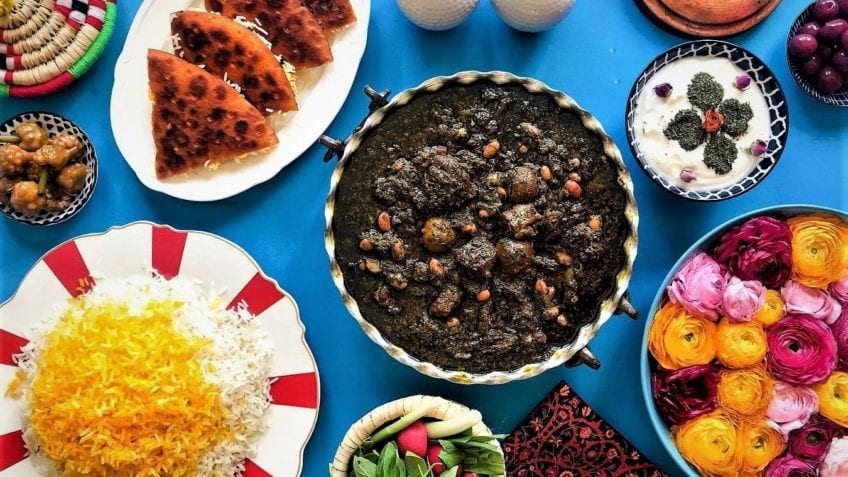
Onions: Sautéed onions are a common base for many Persian dishes, including Fesenjan, providing depth and sweetness to the stew.
Spices: Spices used in Fesenjan can include ground cinnamon, ground cumin, and sometimes a touch of saffron for added fragrance and flavor.
Preparation:
Toasting Walnuts: The process of making Fesenjan begins with toasting and grinding the walnuts into a paste. The toasting not only enhances the flavor of the walnuts but also thickens the sauce.
Sautéing Onions: Sliced onions are sautéed in a bit of oil until they become translucent and slightly caramelized.
Adding Meat: The chicken or duck pieces are added to the onions and browned to create depth of flavor. This step also seals in the meat’s juices.
Simmering: The toasted walnut paste is then added to the pot, along with pomegranate paste and spices. The stew is simmered for a considerable amount of time, allowing the flavors to meld, the sauce to thicken, and the meat to become tender.
Serving:
Fesenjan is typically served with Persian white rice (Chelow), providing a perfect balance to the rich, nutty, and tangy stew. Some variations of Fesenjan include additional ingredients such as saffron, ground meat, or pomegranate seeds for garnish.
Fesenjan is a cherished dish in Iranian cuisine and is often enjoyed during special occasions and holidays, particularly at weddings, engagement ceremonies, and other celebrations. Its combination of sweet and sour notes, along with the creamy richness of ground walnuts, makes it a unique and indulgent culinary experience.
5.Zereshk Polo
A rice dish cooked with barberries, often served with chicken. It’s both sweet and sour.
Zereshk Polo is a delicious Persian rice dish that features a combination of aromatic saffron-infused rice and barberries (zereshk). It’s known for its unique sweet and sour flavor profile, which makes it a popular and beloved dish in Iranian cuisine. Here’s more about Zereshk Polo:
Ingredients:
Barberries (Zereshk): Barberries are small, tangy, and red berries used as a key ingredient in Zereshk Polo. They are dried and then rehydrated before being used in the dish.
Saffron: Saffron threads are used to infuse the rice with a beautiful golden color and a subtly floral aroma.
Basmati Rice: Long-grain Basmati rice is the preferred rice for this dish due to its fragrance and the way it cooks into separate, fluffy grains.
Spices: Common spices used include ground cinnamon and a touch of ground cardamom, which adds a warm and aromatic flavor.
Sweetener: To enhance the sweet and sour balance of Zereshk Polo, sugar or a sweetener such as honey or agave syrup may be added to the barberries.
Oil or Butter: Oil or butter is used to cook the rice and sauté the barberries, imparting richness and flavor.
Preparation:
Rice Preparation: The process begins by washing and soaking the rice. The rice is then parboiled in salted water until it’s partially cooked. It’s important not to overcook the rice at this stage to maintain the desired texture.
Saffron Infusion: Saffron threads are soaked in warm water or milk to release their flavor and color. A portion of the partially cooked rice is then mixed with the saffron infusion to give it a golden hue.
Layering: The partially cooked plain rice is layered with the saffron-infused rice. Barberries are typically sautéed in a bit of oil or butter and sometimes sweetened with sugar or honey. They are then spread as a layer between the rice.
Steaming: The layered rice and barberries are steamed to allow the flavors to meld and to ensure that the rice is fully cooked.
Serving:
Zereshk Polo is often served with various accompaniments, which may include a choice of protein such as chicken or lamb. The sweet and sour barberries pair beautifully with the savory meat. Additionally, the dish is garnished with additional saffron threads for a delightful presentation.
Zereshk Polo is a popular dish in Iranian cuisine, often enjoyed on special occasions, celebrations, and during family gatherings. The contrast of the tart barberries with the fragrant saffron rice creates a delightful combination of flavors that makes it a staple in Persian culinary tradition.
6.Adas Polo
A flavorful rice dish made with lentils, raisins, and dates, often served with chicken or lamb.
Adas Polo is a flavorful and aromatic Persian rice dish that is known for its unique combination of lentils, raisins, and dates. It’s a sweet and savory dish that is popular in Iranian cuisine. Here’s more about Adas Polo:
Ingredients:
Basmati Rice: Long-grain Basmati rice is the rice of choice for Adas Polo due to its fragrance and the way it cooks into separate, fluffy grains.
Lentils: Brown or green lentils are typically used in Adas Polo. These lentils add a hearty and earthy flavor to the dish.
Raisins: Raisins provide natural sweetness and a delightful contrast to the savory elements of the dish.
Dates: Dates are used to add another layer of sweetness and a chewy texture.
Onions: Sautéed onions provide a savory and aromatic base for the dish.
Spices: Common spices used in Adas Polo include ground cinnamon and ground cumin. These spices give the dish its warm and aromatic flavor.
Oil or Butter: Oil or butter is used to sauté the onions and sometimes to cook the rice, imparting richness and flavor.
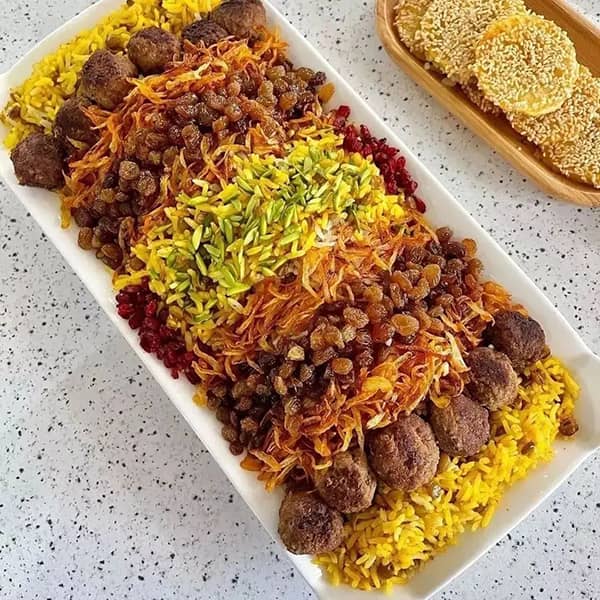
Preparation:
Rice Preparation: The process begins by washing and soaking the rice. The rice is then parboiled in salted water until it’s partially cooked. It’s important not to overcook the rice at this stage to maintain the desired texture.
Lentils: Lentils are boiled separately until they are partially cooked. This is done to ensure that the lentils are tender and cooked through when the dish is complete.
Layering: The partially cooked rice is layered with the partially cooked lentils, raisins, and dates. This layering allows the flavors to meld.
Spices and Aromatics: Sautéed onions and a mixture of ground cinnamon and cumin are added for a warm and savory flavor profile.
Steaming: The layered rice and lentils are steamed together to finish the cooking process. This allows the rice to absorb the flavors of the lentils, spices, and aromatics.
Serving:
Adas Polo is often garnished with additional raisins and sautéed or caramelized onions for added sweetness and texture. The dish can be served with a choice of protein such as chicken or lamb, creating a balanced and satisfying meal.
Adas Polo is enjoyed on various occasions and celebrations in Iran, as well as during everyday family meals. The sweet and savory combination, along with the fragrant spices, makes it a distinctive and delightful dish that is cherished in Persian cuisine.
7.Mirza Ghasemi
A roasted eggplant dish mixed with garlic, tomatoes, and eggs. It’s typically served with flatbread.
Mirza Ghasemi is a delicious and flavorful Iranian dish that hails from the northern part of Iran, particularly from the Gilan and Mazandaran provinces. It is a smoky eggplant and tomato dish that is often served as an appetizer or side dish. Here’s more about Mirza Ghasemi:
Ingredients:
Eggplant (Aubergine): Large eggplants are typically used for this dish. The eggplants are often charred or roasted to add a smoky flavor.
Tomatoes: Fresh, ripe tomatoes are chopped or grated to create a rich tomato base for the dish.
Garlic: Lots of garlic is a key ingredient in Mirza Ghasemi, contributing to its intense flavor.
Eggs: This dish is enriched with beaten eggs, which give it a creamy and custardy texture.
Spices: Spices such as turmeric, salt, and black pepper are used to season the dish.
Vegetable Oil: Vegetable oil is used for sautéing the ingredients and preventing sticking.
Preparation:
Eggplant Roasting: The eggplants are typically charred or roasted until the skin becomes blackened and the flesh is softened. This process imparts a smoky flavor to the eggplants, which is a hallmark of Mirza Ghasemi. The roasted eggplants are then peeled and their flesh is mashed.
Sautéing: Chopped garlic and grated tomatoes are sautéed in a pot until they become fragrant and start to soften.
Adding Eggplant: The mashed roasted eggplant is added to the pot and mixed with the garlic and tomatoes. The mixture is cooked together until it’s well combined and the flavors meld.
Seasoning: The dish is seasoned with turmeric, salt, and black pepper. These spices add depth and warmth to the flavor.
Adding Eggs: Beaten eggs are slowly poured into the mixture, and they are continuously stirred to create a creamy and custardy texture as they cook.
Simmering: The dish is simmered until the eggs are fully cooked, and the flavors are well integrated.
Serving:
Mirza Ghasemi is traditionally served with flatbread or as a side dish with rice. It can also be garnished with fresh herbs like cilantro or parsley. The smoky and garlicky flavors combined with the creamy egg and tomato base make it a delicious and comforting appetizer or accompaniment to a meal.
Mirza Ghasemi is a regional specialty from the Caspian Sea region of Iran and is appreciated for its unique flavors and simple yet satisfying ingredients. It’s a perfect representation of the diverse and flavorful dishes found in Iranian cuisine.
8.Dizi
A traditional Persian stew made with lamb, chickpeas, white beans, and tomatoes, often served with flatbread.
Dizi, also known as “Abgoosht” or “Persian Lamb Stew,” is a traditional Iranian dish with a rich history and a unique way of serving. Dizi is both the name of the dish and the specific cookware used to prepare and serve it. Here’s more about Dizi:
Ingredients:
Lamb or Beef: Dizi is traditionally made with cuts of lamb or beef. The meat is usually bone-in, which adds depth of flavor to the stew.
Chickpeas and White Beans: These legumes are often included and provide a hearty and nutritious element to the dish.
Tomatoes: Tomatoes are used to create the stew’s base and add a tangy flavor.
Potatoes: Some variations of Dizi include potatoes, which are typically added towards the end of the cooking process to provide starchiness and thickness to the broth.
Turmeric and Other Spices: Spices such as turmeric, salt, and black pepper are commonly used for seasoning. Turmeric provides the dish with its signature golden color.
Onions: Sautéed onions are used to create a flavorful base for the stew.
Dried Lime (Limu Omani): Dried limes are pierced and added to the stew to impart a unique tangy and slightly bitter flavor.
Preparation:
Meat Preparation: The meat is typically cut into chunks and browned to seal in its juices and provide a rich, meaty flavor.
Sautéing Onions: Sautéed onions are an essential part of creating the base for Dizi. They are cooked until they become translucent and slightly caramelized.
Creating the Stew: The browned meat, chickpeas, white beans, tomatoes, and spices are added to the pot. The dried limes are also introduced at this stage.
Simmering: The ingredients are then simmered for a long period of time, allowing the meat to become tender, and the flavors to meld together.
Mashing and Straining: A unique aspect of Dizi is the mashing and straining process. The solids (meat, beans, etc.) and the liquids (broth) are separated. The solid ingredients are usually served with bread, and the broth is served as a soup.
Serving:
Dizi is traditionally served in a specific manner:
The mashed solid ingredients are placed in a separate bowl, often with some of the cooking broth.
The remaining broth is served as a soup.
Flatbreads like lavash are typically served alongside Dizi.
The solids are often eaten with the bread, and you can use a mortar and pestle to further mash them and create a spread. This communal style of serving and eating Dizi is a cherished aspect of the dish, making it a social and cultural experience.
Dizi is a beloved and comforting dish in Iranian cuisine, particularly during the colder months. Its combination of slow-cooked meat, legumes, and aromatic spices creates a hearty and flavorful meal that’s enjoyed by many in Iran.
9.Kashk-e Bademjan
An appetizer made from sautéed eggplants, garlic, and whey, usually served with flatbread.
Kashk-e Bademjan, sometimes spelled as “Kashke Bademjan,” is a popular Persian appetizer that features sautéed eggplants and a creamy topping made from a combination of kashk (a fermented whey product), garlic, and mint. This dish is known for its rich and unique flavors. Here’s more about Kashk-e Bademjan:
Ingredients:
Eggplants (Aubergines): Large eggplants are often used to make Kashk-e Bademjan. They are usually roasted or grilled to develop a smoky flavor and a tender texture.
Kashk: Kashk is a key ingredient in this dish. It is a type of whey product that is fermented and dried. Kashk adds a distinct tangy and creamy element to the dish. It can be found in both liquid and dried forms.
Garlic: Lots of garlic is used in Kashk-e Bademjan to provide a strong and pungent flavor.
Mint: Dried mint is added to the topping mixture to provide a refreshing and aromatic note.
Vegetable Oil: Vegetable oil is used for sautéing the eggplants and garlic.
Salt and Pepper: These seasonings are used to taste, adding to the overall flavor of the dish.
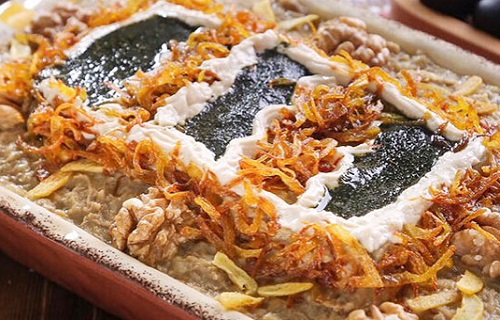
Preparation:
Roasting or Grilling Eggplants: The eggplants are typically roasted or grilled until the skin is charred, and the flesh is tender. This process imparts a smoky flavor to the eggplants, which is a defining characteristic of Kashk-e Bademjan. After roasting, the skin is removed, and the flesh is mashed.
Sautéing Garlic: Chopped or minced garlic is sautéed in oil until it becomes aromatic and slightly browned.
Mixing Eggplants: The mashed roasted eggplants are then added to the garlic and sautéed for a short period to combine the flavors.
Kashk and Mint Topping: A mixture of kashk, dried mint, and sometimes a touch of salt and pepper is prepared separately. This mixture is poured over the eggplant and garlic, creating a creamy and tangy topping.
Serving:
Kashk-e Bademjan is traditionally served as an appetizer, often accompanied by warm flatbreads like lavash or pita. The creamy topping contrasts with the smoky eggplant and the pungent garlic, resulting in a delightful combination of flavors and textures. It’s typically garnished with fresh herbs or additional dried mint.
Kashk-e Bademjan is a beloved dish in Iranian cuisine, appreciated for its rich and complex flavors. The creamy, tangy kashk combined with the smoky eggplant and aromatic garlic and mint make it a unique and satisfying appetizer or side dish.
10.Ash Reshteh
A thick and hearty soup made with herbs, legumes, and noodles. It’s a traditional Persian comfort food.
Ash Reshteh is a hearty and flavorful Persian noodle soup that is loved in Iranian cuisine. It is typically prepared for special occasions, particularly during the Persian New Year (Nowruz) and other celebrations. Here’s more about Ash Reshteh:
Ingredients:
Reshteh Noodles: The dish features a type of flat and ribbon-like Persian noodle called “reshteh.” These noodles are often made from wheat flour and provide a unique texture to the soup.
Herbs: A variety of fresh herbs are used to flavor and garnish Ash Reshteh, including parsley, cilantro, and green onions.
Legumes: A combination of legumes is common in Ash Reshteh. These can include kidney beans, chickpeas, and lentils, adding protein and heartiness to the soup.
Spices: Common spices include ground turmeric, salt, and pepper. Turmeric gives the soup its golden color.
Garlic: Sautéed or crushed garlic is often used to add aromatic depth to the broth.
Kashk: Kashk, the fermented whey product, is used to give the soup a tangy and creamy element. It is typically drizzled on top of individual servings.
Onions: Sautéed onions are used to create a flavorful base for the soup.
Preparation:
Cooking Legumes: The legumes are typically boiled until they are tender. This process can be done in advance to save time when making the soup.
Sautéing Onions and Garlic: Chopped or sliced onions are sautéed until they become translucent and slightly caramelized. Garlic is often added to enhance the flavor.
Herbs and Spices: Fresh herbs are chopped and added to the pot. Spices like turmeric are used to season the soup.
Noodles: The reshteh noodles are typically boiled separately until they are cooked, then added to the soup.
Combining Ingredients: The boiled legumes, sautéed onions and herbs, and cooked noodles are combined to create the soup.
Simmering: The soup is simmered until the flavors meld, and it reaches the desired consistency.

Serving:
Ash Reshteh is traditionally served with kashk drizzled on top of individual servings. It is also garnished with sautéed onions, garlic, and dried mint. It can be served with flatbreads like lavash or pita.
Ash Reshteh is often enjoyed as a special dish during Nowruz, weddings, and other celebrations. Its combination of fresh herbs, legumes, and reshteh noodles provides a unique and satisfying flavor profile that’s appreciated in Persian cuisine.
11.Joojeh Polo
A flavorful chicken and rice dish often flavored with saffron, barberries, and pistachios.
Joojeh Polo is a delicious and popular Persian dish known for its combination of saffron-infused rice and marinated grilled chicken. This aromatic and flavorful dish is a staple of Iranian cuisine. Here’s more about Joojeh Polo:
Ingredients:
Chicken: Joojeh Polo is made with bone-in chicken pieces, usually skinless, which are marinated to infuse them with flavor.
Basmati Rice: Long-grain Basmati rice is the rice of choice in Persian cuisine, known for its fragrance and ability to cook into separate, fluffy grains.
Saffron: Saffron threads are used to infuse the rice with a beautiful golden color and a subtly floral aroma.
Lemon Juice: Lemon juice is often used in the marinade for the chicken to add a touch of citrusy flavor and help tenderize the meat.
Yogurt: Yogurt is another key ingredient in the chicken marinade, adding a creamy texture and tangy flavor.
Spices: Common spices include saffron, ground turmeric, ground black pepper, and sometimes ground cumin.
Onions: Sautéed onions provide a flavorful base for the dish.
Oil or Butter: Oil or butter is used for sautéing the onions, as well as cooking the rice and chicken, imparting richness and flavor.
Preparation:
Marinating Chicken: The chicken pieces are marinated in a mixture of yogurt, lemon juice, saffron, and spices for several hours or overnight. This allows the flavors to permeate the meat and makes it tender.
Rice Preparation: The process begins by washing and soaking the rice. The rice is then parboiled in salted water until it’s partially cooked. It’s important not to overcook the rice at this stage to maintain the desired texture.
Saffron Infusion: Saffron threads are soaked in warm water or milk to release their flavor and color. A portion of the partially cooked rice is then mixed with the saffron infusion to give it a golden hue.
Grilling Chicken: The marinated chicken pieces are grilled until they are fully cooked and have a nice char on the outside.
Sautéing Onions: Sliced onions are sautéed in a bit of oil or butter until they become translucent and slightly caramelized.
Layering: The partially cooked plain rice is layered with the saffron-infused rice, sautéed onions, and the grilled chicken pieces. This layering allows the flavors to meld.
Steaming: The layered rice and chicken are steamed to finish the cooking process, allowing the flavors to meld, and the rice to become fully cooked.
Serving:
Joojeh Polo is traditionally served with a variety of accompaniments, including flatbreads like lavash or pita, grilled tomatoes, and sometimes fresh herbs like mint and basil. The saffron-infused rice provides a perfect contrast to the flavorful and tender grilled chicken.
Joojeh Polo is a cherished and flavorful dish in Iranian cuisine, often enjoyed on special occasions, holidays, and gatherings with family and friends. Its fragrant saffron rice, juicy grilled chicken, and rich, aromatic flavors make it a delectable representation of Persian culinary tradition.
12.Saffron Ice Cream (Bastani)
Iranian ice cream is known for its unique flavors, and saffron ice cream is a must-try.
Saffron Ice Cream, known as “Bastani Sonnati” in Persian, is a delightful and rich dessert that’s cherished in Iranian cuisine. It’s characterized by its creamy texture, aromatic saffron flavor, and the inclusion of rosewater and a unique ingredient called “akbar mashti” or “pistachio cream.” Here’s more about Saffron Ice Cream:
Ingredients:
Saffron: Saffron is the star of this ice cream, infusing it with a beautiful golden color and a distinct floral aroma. It’s one of the most expensive and highly sought-after spices in the world.
Milk and Cream: A mixture of milk and heavy cream is used as the base for the ice cream, creating its creamy and luscious texture.
Sugar: Sugar is used to sweeten the ice cream to taste. The sweetness can be adjusted based on personal preference.
Rosewater: Rosewater is added to the ice cream to provide a fragrant and floral note that complements the saffron.
Pistachio Cream (Akbar Mashti): This is a unique ingredient in Saffron Ice Cream. Akbar Mashti is a combination of pistachio paste, rosewater, and sugar, which adds a distinctive flavor and texture to the ice cream.
Preparation:
Saffron Infusion: Saffron threads are soaked in warm milk to release their flavor and color. This saffron-infused milk forms the base of the ice cream.
Heating the Mixture: The saffron milk, cream, sugar, and rosewater are combined in a saucepan and heated until the sugar is dissolved. The mixture is then allowed to cool.
Churning: The cooled mixture is poured into an ice cream maker, and it’s churned until it reaches a soft-serve consistency.

Adding Akbar Mashti: The Akbar Mashti or pistachio cream is added to the churning ice cream. It provides a unique flavor, creaminess, and chunks of pistachio.
Freezing: Once the Akbar Mashti is incorporated, the ice cream is transferred to a container and frozen until it reaches the desired firmness.
Serving:
Saffron Ice Cream is often served in a few distinct ways:
As a Scoop: It can be scooped into bowls or cones, just like traditional ice cream.
Between Wafers: Saffron Ice Cream is sometimes sandwiched between two thin wafers, creating a delectable treat called “Bastani-e Gooshfil.”
With Faloodeh: Saffron Ice Cream is commonly served with “Faloodeh,” a Persian dessert made from frozen vermicelli noodles and rosewater syrup. The combination of creamy ice cream and refreshing Faloodeh is a beloved pairing.
Saffron Ice Cream is enjoyed year-round but is particularly refreshing during the warm summer months. Its luxurious saffron and rosewater notes, combined with the creamy texture and the delightful addition of Akbar Mashti, make it a highly sought-after dessert in Persian cuisine.
13.Tahchin
A delectable baked rice cake dish often made with saffron, yogurt, and chicken or lamb.
Tahchin, also spelled “Tah-chin” or “Tah chin,” is a traditional Persian rice dish known for its crispy golden crust and flavorful, saffron-infused rice. It is often prepared with chicken or lamb and can include a variety of ingredients and seasonings. Here’s more about Tahchin:
Ingredients:
Basmati Rice: Long-grain Basmati rice is used to make Tahchin, known for its fragrance and the way it cooks into separate, fluffy grains.
Saffron: Saffron threads are used to infuse the rice with a beautiful golden color and a subtly floral aroma.
Yogurt: Yogurt is one of the key ingredients in Tahchin, providing a creamy texture and tangy flavor. It also helps create the crust when cooked.
Eggs: Beaten eggs are used to bind the rice and yogurt mixture together.
Meat: Chicken or lamb are the most common choices of meat for Tahchin. The meat is typically cooked, cubed, and layered within the rice.
Spices: Spices like turmeric, salt, and black pepper are used to season the dish.
Sour Barberries (Zereshk): Barberries are sometimes used in Tahchin to provide a tangy and slightly sour element. They are often garnished on top of the dish.
Preparation:
Rice Preparation: The process begins by washing and soaking the rice. The rice is then parboiled in salted water until it’s partially cooked. It’s important not to overcook the rice at this stage to maintain the desired texture.
Saffron Infusion: Saffron threads are soaked in warm water or milk to release their flavor and color. A portion of the partially cooked rice is then mixed with the saffron infusion to give it a golden hue.
Layering: The partially cooked plain rice is layered with the saffron-infused rice, yogurt, beaten eggs, and the cooked meat. This layering allows the flavors to meld together.
Steaming: The layered rice and other ingredients are steamed to finish the cooking process. This creates the crispy, golden crust on the bottom of the dish.
Serving:
Tahchin is traditionally served as a main dish, often accompanied by flatbreads like lavash or pita. It can also be garnished with sour barberries for added tang and a colorful presentation.
Tahchin is a popular dish in Persian cuisine and is often enjoyed during special occasions, celebrations, and gatherings with family and friends. Its crispy, saffron-infused crust, along with the tender meat and aromatic rice, creates a unique and flavorful culinary experience.
14.Gheimeh
Gheimeh (also spelled “Ghormeh” or “Ghormeh”) is a popular Persian stew that is well-loved and widely consumed in Iranian cuisine. It’s known for its rich and savory flavor profile, featuring chunks of meat, split peas, and a variety of herbs and spices. Here’s more about Gheimeh:
Ingredients:
Lamb or Beef: Gheimeh is typically made with lamb or beef. The meat is cut into chunks and slowly cooked until tender, contributing to the stew’s richness.
Yellow Split Peas: Yellow split peas are one of the main ingredients in Gheimeh, adding a creamy texture and a slightly sweet flavor.
Dried Limes (Limu Omani): Dried limes are a crucial ingredient, providing a tangy and slightly bitter flavor to the stew.
Onions: Sautéed onions are used to create the base for the dish, adding depth and sweetness.
Spices: Common spices include ground turmeric, ground cumin, and sometimes a touch of saffron for added fragrance and flavor.
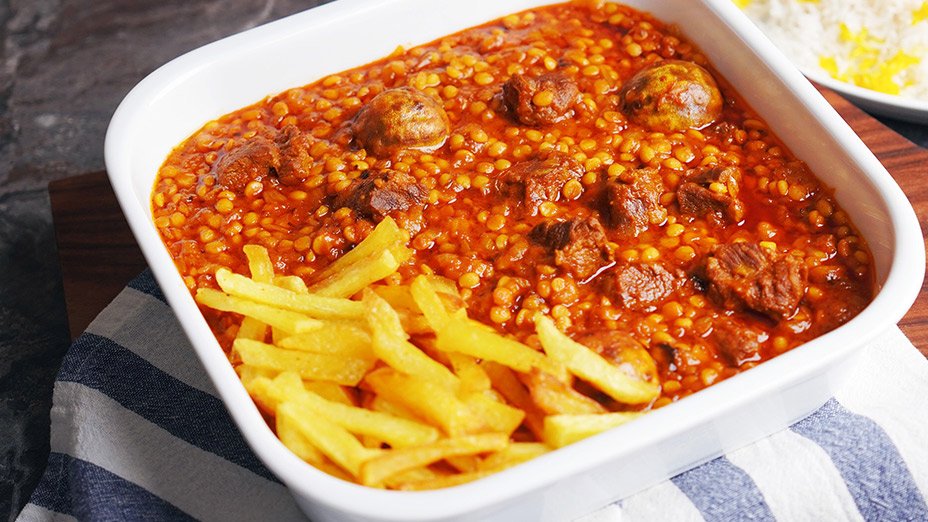
Tomato Paste: Tomato paste is used to create a rich tomato base for the stew.
Oil or Butter: Oil or butter is used for sautéing the onions and meat, imparting richness and flavor.
Herbs: Fresh herbs like parsley, cilantro, and fenugreek leaves are used to flavor and garnish the dish.
Preparation:
Sautéing: Sautéed onions are the first step. They are cooked until they become translucent and slightly caramelized.
Meat Browning: The chunks of lamb or beef are added to the onions and browned to seal in their juices and create a rich, meaty flavor.
Split Peas: The yellow split peas, along with tomato paste, dried limes, and spices, are added to the pot. Water is added, and the stew is simmered for an extended period to ensure the peas are fully cooked and the flavors meld.
Serving:
Gheimeh is traditionally served with Persian white rice (Chelow), creating a perfect balance to the rich and savory stew. The dish can also be garnished with a side of fried potato sticks, which add a crispy texture and a complementary flavor.
Gheimeh is a beloved dish in Iranian cuisine and is often enjoyed on various occasions and during family gatherings. Its combination of tender meat, creamy split peas, the unique tang of dried limes, and fragrant spices creates a flavorful and comforting meal that is deeply appreciated in Persian culinary tradition
15.Abgoosht
A hearty Persian soup that consists of slow-cooked lamb or beef, chickpeas, and various spices, traditionally eaten with flatbread.
Abgoosht, also known as “Dizi” or “Persian Lamb Stew,” is a traditional and beloved Iranian dish with a history dating back many centuries. It’s not just a meal but a cultural experience, as it’s traditionally served in a specific manner, often using a unique type of cookware. Here’s more about Abgoosht:
Ingredients:
Lamb or Beef: Abgoosht is traditionally made with cuts of lamb or beef, and the meat is usually bone-in, which adds depth of flavor to the stew.
Chickpeas and White Beans: These legumes are often included and provide a hearty and nutritious element to the dish.
Tomatoes: Fresh tomatoes are typically used to create a rich tomato base for the stew.
Potatoes: Some variations of Abgoosht include potatoes, which are typically added towards the end of the cooking process to provide starchiness and thickness to the broth.
Turmeric and Other Spices: Common spices used include ground turmeric, salt, and black pepper. Turmeric gives the dish its signature golden color.
Onions: Sautéed onions provide a flavorful base for the stew.
Dried Lime (Limu Omani): Dried limes are pierced and added to the stew to impart a unique tangy and slightly bitter flavor.
Preparation:
Meat Preparation: The meat is typically cut into chunks and browned to seal in its juices and provide a rich, meaty flavor.
Sautéing Onions: Sautéed onions are an essential part of creating the base for Abgoosht. They are cooked until they become translucent and slightly caramelized.
Creating the Stew: The browned meat, chickpeas, white beans, tomatoes, and spices are added to the pot. The dried limes are also introduced at this stage.
Simmering: The ingredients are then simmered for a long period of time, allowing the meat to become tender, and the flavors to meld together.
Mashing and Straining: A unique aspect of Abgoosht is the mashing and straining process. The solids (meat, beans, etc.) and the liquids (broth) are separated. The solid ingredients are usually served with bread, and the broth is served as a soup.
Serving:
Abgoosht is traditionally served in a specific manner:
The mashed solid ingredients are placed in a separate bowl, often with some of the cooking broth.
The remaining broth is served as a soup.
Flatbreads like lavash are typically served alongside Abgoosht.
The solids are often eaten with the bread, and you can use a mortar and pestle to further mash them and create a spread. This communal style of serving and eating Abgoosht is a cherished aspect of the dish, making it a social and cultural experience.
Abgoosht is a beloved and comforting dish in Iranian cuisine, particularly during the colder months. Its combination of slow-cooked meat, legumes, and aromatic spices creates a hearty and flavorful meal that’s enjoyed by many in Iran.
16.Shirin Polo
A sweet and aromatic Persian rice dish made with saffron, orange peel, and slivered pistachios, often served with a meat dish like chicken or lamb.
Shirin Polo, also known as “Sweet Rice Pilaf,” is a classic Persian dish that combines fragrant and sweet flavors with rice and a variety of ingredients to create a delightful and aromatic dish. Here’s more about Shirin Polo:
Ingredients:
Basmati Rice: Long-grain Basmati rice is the preferred choice for Shirin Polo due to its fragrance and ability to cook into separate, fluffy grains.
Saffron: Saffron threads are used to infuse the rice with a beautiful golden color and a subtly floral aroma.
Nuts: A variety of nuts like almonds, pistachios, and orange peels are often included, adding a delightful crunch and texture to the dish.
Dried Fruits: Dried fruits such as barberries (zereshk), raisins, and sometimes dried apricots or plums are used, adding sweetness and a contrasting texture.
Spices: Common spices include ground cinnamon, ground cardamom, and sometimes a touch of rosewater for added fragrance.
Sugar: Sugar is used to sweeten the rice, giving it its characteristic sweet flavor.
Oil or Butter: Oil or butter is used to sauté the nuts, fruits, and spices, imparting richness and flavor.
Preparation:
Rice Preparation: The process begins by washing and soaking the rice. The rice is then parboiled in salted water until it’s partially cooked. It’s important not to overcook the rice at this stage to maintain the desired texture.
Saffron Infusion: Saffron threads are soaked in warm water or milk to release their flavor and color. A portion of the partially cooked rice is then mixed with the saffron infusion to give it a golden hue.
Layering: The partially cooked plain rice is layered with the saffron-infused rice, nuts, dried fruits, sugar, and spices. This layering allows the flavors to meld together.
Steaming: The layered rice and other ingredients are steamed to finish the cooking process, ensuring that the rice is fully cooked and the flavors are well integrated.
Serving:
Shirin Polo is often served as a side dish, particularly during special occasions and festive gatherings. It pairs wonderfully with main dishes like chicken, lamb, or fish. The sweet and aromatic profile of the rice contrasts beautifully with savory main courses.
Shirin Polo is a beloved and elegant dish in Iranian cuisine. Its combination of fragrant saffron, sweet dried fruits, crunchy nuts, and aromatic spices creates a unique and satisfying flavor profile that adds a touch of sophistication to Persian meals.
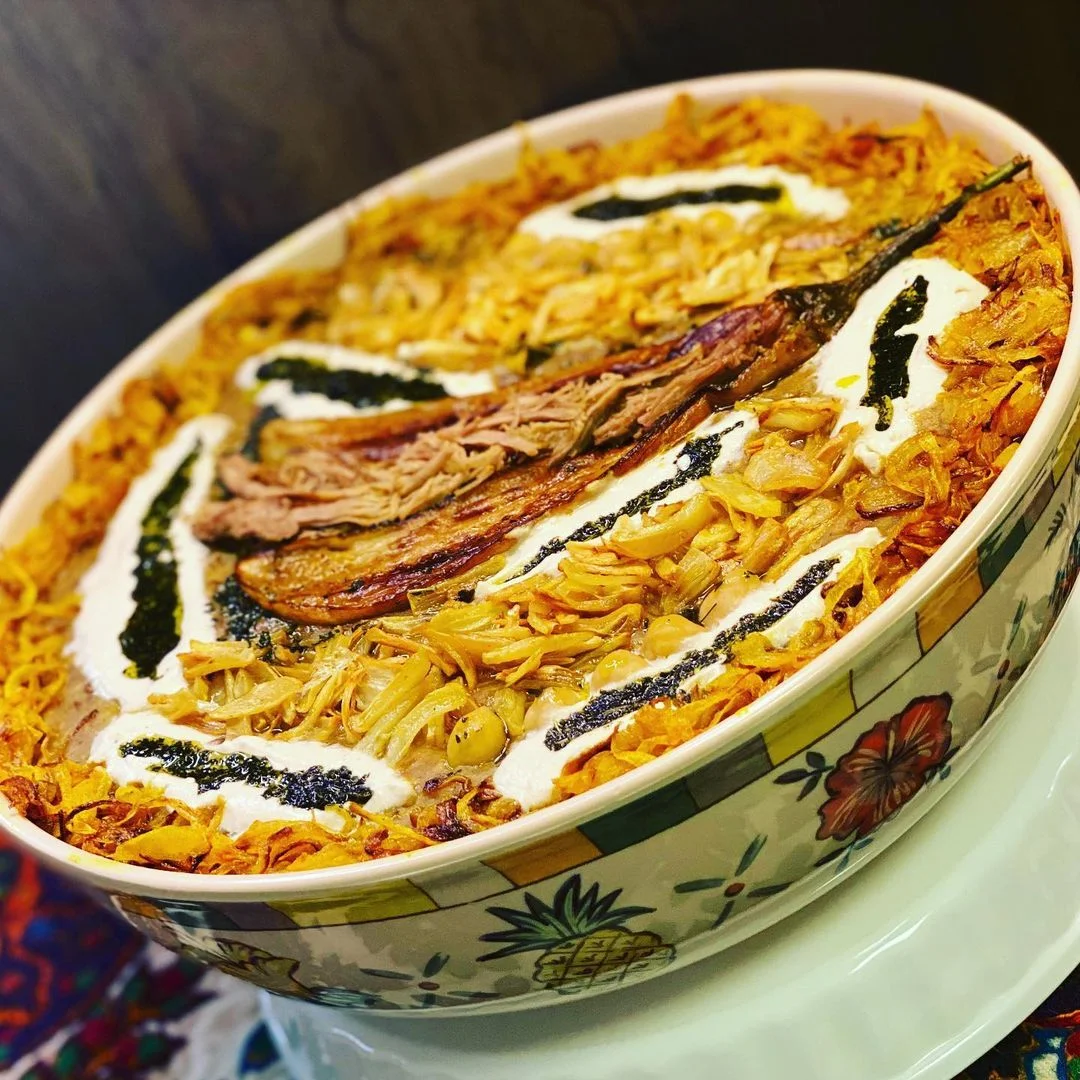
17.Halima Badmjan
Halima Badmjan ` This is a wonderful description of how to prepare this delicious dish. It’s a rich and flavorful Iranian dish that combines eggplants, lentils, saffron, and meat. The steps you’ve described make it clear how to create this tasty and hearty meal. Here’s a summary of the steps you’ve provided:
Ingredients:
Eggplant (1 kilo)
Lentils (1 pint)
Fried onions (1 cup)
Saffron curd (1 cup)
Mutton (500 grams)
Fried garlic (1-2 tablespoons)
Iranian saffron (1/2 cup)
Hot mint (1/4 cup)
Fresh garlic (2 cloves)
Salt, pepper, cinnamon, and turmeric (to taste)
Oil (as needed)
Powdered walnuts (for decoration)
Preparation:
1. Start by soaking the peeled and cut eggplants in water and salt for a few hours. This helps reduce the oil absorption during frying and removes any bitterness if the eggplants are bitter.
2. Cook the lentils with some water and a little cinnamon to warm the dish and balance the lentils’ flavor.
3. Fry the onions until they turn golden brown.
4. Boil the saffron curd and add saffron to infuse it with saffron flavor and color.
5. In a separate pan, fry the dry mint with a little oil for about 2 minutes, taking care not to burn it so that it retains its green color.
6. Fry the meat with a bit of black pepper, fried onions, raw garlic, and turmeric. Cook it until the meat is tender, adding a little water if necessary.
7. After all the ingredients are prepared, grate the fried eggplants, and blend the cooked meats, lentils, and eggplants together with an electric or hand blender until well mixed.
8. Transfer the mixture to a serving container and decorate it with powdered walnuts, hot mint, garlic, and saffron curd as desired.
The result is a flavorful and aromatic dish that’s rich in texture and taste.
18.Faloodeh Shirazi
Faloodeh Shirazi, often simply referred to as “Faloodeh,” is a traditional Persian frozen dessert that is particularly popular during the hot summer months in Iran. It’s a refreshing and cooling treat known for its unique texture and sweet, slightly tangy flavor. Here’s more about Faloodeh Shirazi:
Ingredients:
Rice Noodles: Faloodeh is made with thin, translucent rice noodles that provide a unique texture to the dessert.
Sugar: Sugar is used to sweeten the dish to taste, and it’s an essential component in creating the syrup.
Rosewater: Rosewater is added to the sugar syrup, giving Faloodeh its signature floral aroma and flavor.
Lime or Lemon Juice: A small amount of lime or lemon juice is used to provide a slightly tangy and refreshing element to the dessert.
Preparation:
Cooking Rice Noodles: The rice noodles are typically boiled until they are soft but not mushy. They are then rinsed under cold water to cool and firm them up.
Sugar Syrup: Sugar is dissolved in water to create a sweet syrup. Rosewater and lime or lemon juice are added to the syrup to infuse it with the desired flavors.
Mixing and Freezing: The cooled rice noodles are mixed with the sweet syrup, creating a mixture that is then poured into a shallow container or a special ice cream maker designed for Faloodeh. The mixture is frozen until it reaches the desired consistency.
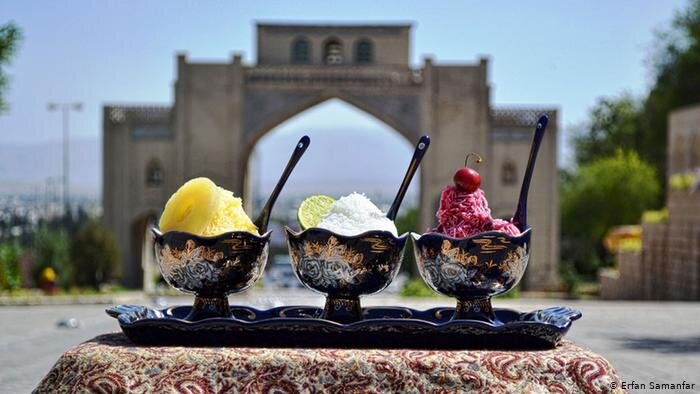
Serving:
Faloodeh is traditionally served in several ways:
On Its Own: Faloodeh can be enjoyed as a standalone dessert, served in small bowls or dishes.
With Sour Cherry Syrup: It’s common to serve Faloodeh with a drizzle of sour cherry syrup (sharbat-e albaloo) to add a delightful sweet and tart contrast.
Garnishes: Garnishes like crushed ice, lime or lemon zest, and sometimes ground pistachios can be added to enhance the presentation and flavor.
Faloodeh Shirazi is a beloved and iconic Iranian dessert, particularly popular in the city of Shiraz, where it is said to have originated. Its refreshing and unique texture, combined with the floral notes of rosewater and the slight tang of lime or lemon, make it a delightful treat, especially on hot summer days.
19.Isfahan Biryani
It’s a fascinating and unique dish from Isfahan, Iran, with a distinct preparation method and combination of flavors. Here’s a summary of the steps you’ve described for making Isfahan Biryani:
Ingredients:
Meat
Onions
Spices
White liver
Salt, pepper, and turmeric
Oil
Sangak bread (a type of Iranian flatbread)
Cinnamon powder
Aromatic herbs (basil, mint, dried and powdered tarragon)
Almond slices
Saffron
Fresh vegetables
Buttermilk
Preparation:
1. Cook the Meat: Cook the meat with two onions and spices until it’s tender and flavorful.
2. Prepare the White Liver: Grind and fry the white liver after cooking.
3. Grind the Cooked Meat:Grind the cooked meat with the remaining two onions. Add salt, pepper, and turmeric to taste, but do not mix them together.
4. Prepare the Pan: Pour a little oil in a small pan with a special spatula for Isfahan Biryani, ensuring that the bottom becomes greasy and hot.
5. Form the Biryani: Spread each Biryani portion to the size of a hamburger or in an oval shape on the bottom of the pan. Heat it.
6. Assemble the Biryani: When the Biryani gets hot, pour a spoonful of thick meat juice on a piece of Sangak bread, moistening the bread slightly. Sprinkle cinnamon powder on the wet bread. Turn the Biryani onto the bread, then add aromatic herbs such as basil, mint, and dried and powdered tarragon. Finally, put some cooked and fried white liver on the side of the Biryani.
7. Decorate and Serve:Decorate the surface of Isfahan Biryani with almond slices dipped in saffron. Serve this dish with fresh vegetables and buttermilk.
Isfahan Biryani appears to be a flavorful and visually appealing dish with a combination of meat, spices, herbs, and the unique use of Sangak bread as a base. The inclusion of white liver, cinnamon, and saffron-infused almonds adds to its distinctiveness. It’s no wonder this dish is popular among both locals and tourists in Isfahan.
20.Bagali Pilou with Meat
This is a classic Iranian dish that combines rice, meat, beans, and a variety of flavorful spices and herbs to create a delicious and hearty meal. Here’s a summary of the steps you’ve described for preparing this dish:
Ingredients:
3 cups of rice
400 grams of meat (such as neck and muscle of sheep)
1 cup of beans
1/5 cup of dill
2 onions
1 carrot
1 small bell pepper
2 cloves of garlic
Saffron threads
2 tablespoons of tomato paste
3 bay leaves
1/2 teaspoon of turmeric
Ground cinnamon
Salt, black pepper, and red pepper (to taste)
1 tablespoon of animal oil
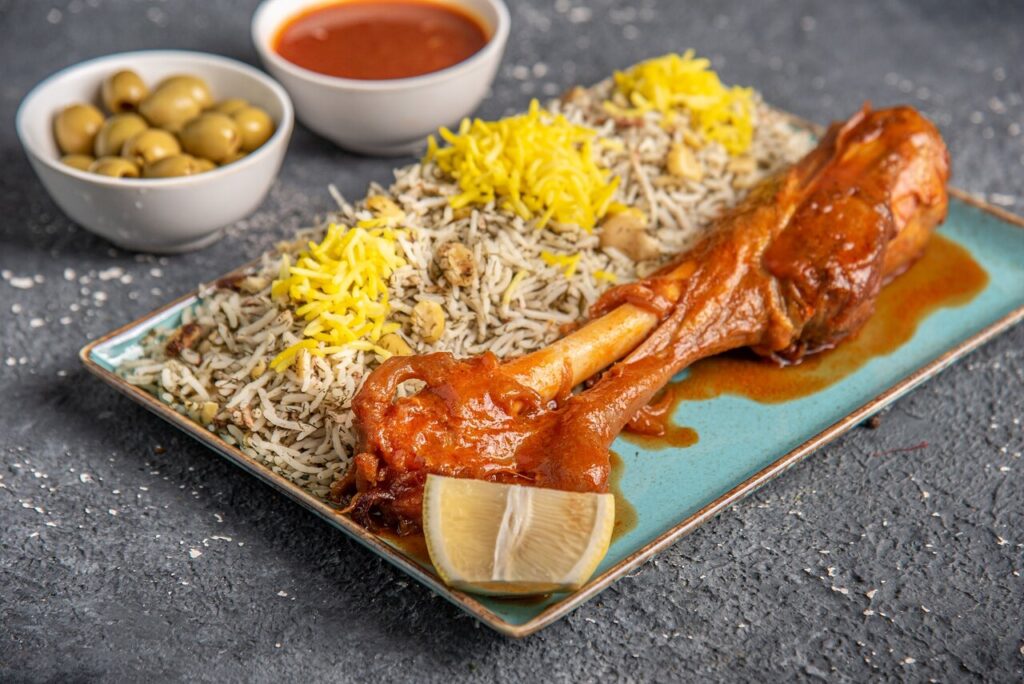
Preparation:
1. Rinse the Rice: Start by rinsing the rice with water and salt. Clean the meat as well.
2. Sauté Onions: Peel and slice one onion, then fry it in a suitable pan with a little oil.
3. Add Meat: Add the cleaned meat to the sautéed onion.
4. Include Spices: Add spices, including salt, black and red pepper, cinnamon stick, and turmeric to the meat. Also, add bay leaves and pour in boiling water. Let it cook for about 3 hours.
5. Cook Rice: In a separate pot, boil water, then add the soaked rice. Once the rice is slightly softened, add the cleaned and washed dill to it and stir. Drain the rice and dill mixture.
6. Combine Rice and Beans: If you use dried dill, add it to the rice in a colander and gently stir until the dill is mixed with the rice. Add the previously cooked beans to the rice.
7. Prepare the Pot: If you want to make rice in a mold for individual servings, heat some oil with saffron in a smaller pot. Add a base to the pot, which can be potatoes, sesame seeds, or anything you prefer. Pour the mixed rice on the bottom of the pot.
8. Create Holes in Rice: Pull the sides of the rice to the middle and make deep holes in it with the bottom of a spatula. Add butter and let it melt and infuse.
9. Prepare Meat Stew:After cooking the meat, strain the cooked meat juice and set it aside.
10. Fry Vegetables: Cut one onion into slices and fry it with animal oil. Add carrot rings and continue frying. Add finely chopped bell pepper and spices (salt, black and red pepper, cinnamon powder, curry spice, and optional garlic powder and Omani lemon powder).
11. Add Meat: Add the meat to the onion mixture and fry until the meat is slightly browned.
12. Incorporate Saffron: Add brewed saffron to the meat and stir.
13. Add Water: Since you’ve already cooked the meat, add a small amount of water to the stew and let it simmer.
14. Serve: After cooking the meat and rice, transfer them to a suitable serving dish and enjoy.








